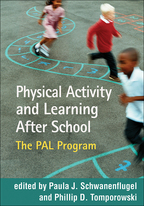Physical Activity and Learning After School
The PAL Program
Edited by Paula J. Schwanenflugel and Phillip D. Tomporowski
“This spectacular book presents an evidence-based after-school program model founded on holistic child development and configured to achieve multiple outcomes. Among other elements, it gives physical education a much-needed 21st-century makeover. The authors' approach could be scaled up to benefit millions of children, as well as their teachers, parents, and surrounding communities.”
—Hal A. Lawson, PhD, Professor of Educational Leadership and Policy Studies and Professor of Social Welfare, University at Albany, State University of New York
“A great help and inspiration to anyone looking to launch a new after-school program or maximize the benefits of an existing program. The book provides a clear picture of how to structure a program to support students' physical, emotional, and academic development. Throughout, the methods are grounded in research and specific examples documenting how after-school programs can go beyond childcare to become an undeniable factor in student success.”
—Molly Goldman, Site Director, Wingspan Arts, New York City
“The authors' approach bridges disciplines to give us a unique perspective on children’s learning and development. Instructors will want to share this book with their students who are preparing to become teachers, participating in community service learning courses and internships, or interested in intervention design and program evaluation. For practitioners, teachers, and after-school personnel, there is a wealth of hands-on guidance for implementing holistic activities that promote academic learning and social and physical growth. For researchers and teacher educators, the book provides a model for the design, implementation, and evaluation of translational intervention programs that can truly make a difference in the lives of children and families.”
—Claire E. Hamilton, PhD, Department of Teacher Education and Curriculum Studies, University of Massachusetts Amherst
“The potential value of after-school programs for young people’s healthy development and learning is well understood, and there is a growing awareness of the vital importance of weaving positive physical activity experiences into young lives. This important book brings these two exciting areas of research together, providing numerous lessons learned from what emerges as a richly multifaceted project that can be adapted and adopted in the real world of students and schools. It has been a long time since I have read a scholarly book that offers such a great deal of inspiration for practical application and innovation.”
—Richard Bailey, PhD, Head of Research, International Council of Sport Science and Physical Education
“This valuable book offers rarely-seen insight into the theoretical underpinnings, instructional strategies, and deep-think planning that support the development of a model approach to enhancing children’s health and academic performance during out-of-school time. Each chapter is an education, carefully crafted to provide sufficient overview, details, and rationale. Covering issues from evaluation to physical movement to mathematics and literacy learning challenges, the volume makes a meaningful contribution to our understanding of interventions that work to safeguard children’s well-being.”
—Georgia Hall, PhD, Senior Research Scientist, National Institute on Out-of-School Time; Associate Director, Wellesley Centers for Women
Table of Contents
1. The Physical Activity and Learning Program and the 21st Century Community Learning Centers Initiative, Bryan A. McCullick and Phillip D. Tomporowski2. Understanding After-School Programming for Elementary School Children, Paula J. Schwanenflugel
3. The Importance of Process Evaluation for After-School Programs, Katherine Wargo and Jennifer L. Gay
4. The Development of Physical Activity Games: Theory and Research Overview, Phillip D. Tomporowski and Bryan A. McCullick
5. The PAL Physical Activity Games Program in an Experimental After-School Setting, E. Nicole McCluney
6. The Challenges Struggling Learners Face in Mathematics, Martha M. Carr
7. The PAL Mathematics Enrichment Program and Challenges in the After-School Setting, Yi-Jung Lee
8. Reading Fluency Practice as Reading Enrichment in After-School Literacy Programming, Paula J. Schwanenflugel
9. Improving Informational Text Literacy: Using Social Studies Education Theory to Promote Social Studies Literacy After School, Justin T. Dooly
10. The PAL Reading Enrichment Program in an Experimental After-School Setting, Megan P. Brock and Paula J. Schwanenflugel
Index
About the Editors
Paula J. Schwanenflugel, PhD, is Professor of Educational Psychology at the University of Georgia. Dr. Schwanenflugel is author or coauthor of several books and numerous book chapters and journal articles on the development of reading fluency and vocabulary learning in young children. She is a codirector of the Physical Activity and Learning (PAL) Program, a project involving faculty from multiple disciplines at the University of Georgia. Dr. Schwanenflugel oversees the PAL reading enrichment program.Phillip D. Tomporowski, PhD, is Professor of Kinesiology at the University of Georgia. Dr. Tomporowski is author or coauthor of several books and numerous book chapters and journal articles on the role of exercise in improving cognitive functioning in children and older adults. He is the principal investigator and director of the Physical Activity and Learning (PAL) Program, a project involving faculty from multiple disciplines at the University of Georgia.
Contributors
Megan P. Brock, MS, Department of Educational Psychology, College of Education, University of Georgia, Athens, GeorgiaMartha M. Carr, PhD (deceased), Department of Educational Psychology, College of Education, University of Georgia, Athens, Georgia
Justin T. Dooly, MAT, Department of Educational Theory and Practice, College of Education, University of Georgia, Athens, Georgia
Jennifer L. Gay, PhD, College of Public Health, University of Georgia, Athens, Georgia
Yi-Jung Lee, MS, Department of Mathematics and Science Education, College of Education, University of Georgia, Athens, Georgia
E. Nicole McCluney, MS, Department of Kinesiology, College of Education, University of Georgia, Athens, Georgia
Bryan A. McCullick, PhD, Department of Kinesiology, College of Education, University of Georgia, Athens, Georgia
Paula J. Schwanenflugel, PhD, Department of Educational Psychology, College of Education, University of Georgia, Athens, Georgia
Phillip D. Tomporowski, PhD, Department of Kinesiology, College of Education, University of Georgia, Athens, Georgia
Katherine Wargo, MPH, Centers for Disease Control and Prevention, Atlanta, Georgia
